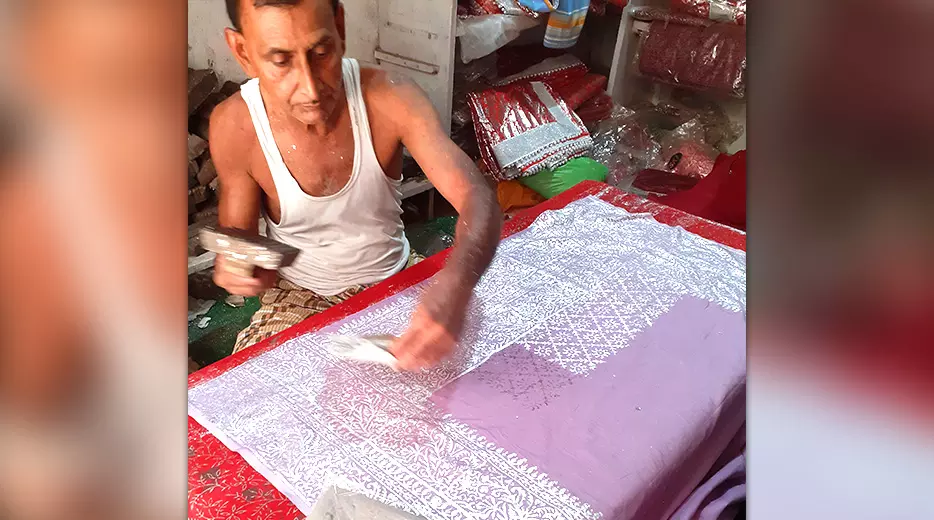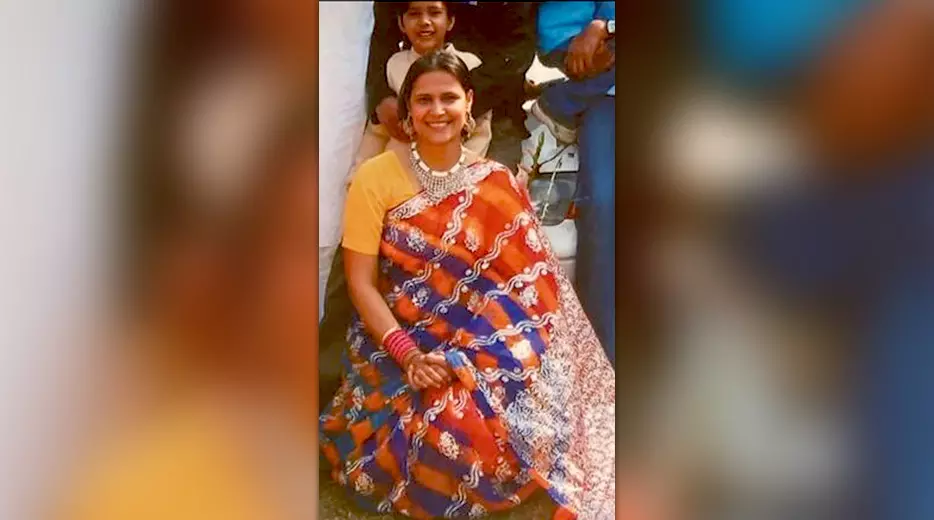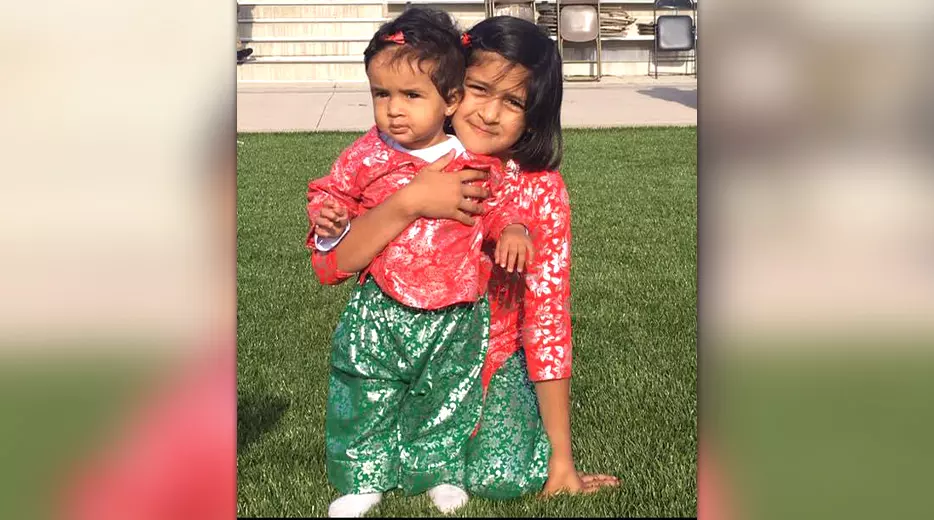
- Home
- India
- World
- Premium
- THE FEDERAL SPECIAL
- Analysis
- States
- Perspective
- Videos
- Sports
- Education
- Entertainment
- Elections
- Features
- Health
- Business
- Series
- In memoriam: Sheikh Mujibur Rahman
- Bishnoi's Men
- NEET TANGLE
- Economy Series
- Earth Day
- Kashmir’s Frozen Turbulence
- India@75
- The legend of Ramjanmabhoomi
- Liberalisation@30
- How to tame a dragon
- Celebrating biodiversity
- Farm Matters
- 50 days of solitude
- Bringing Migrants Home
- Budget 2020
- Jharkhand Votes
- The Federal Investigates
- The Federal Impact
- Vanishing Sand
- Gandhi @ 150
- Andhra Today
- Field report
- Operation Gulmarg
- Pandemic @1 Mn in India
- The Federal Year-End
- The Zero Year
- Science
- Brand studio
- Newsletter
- Elections 2024
- Events
How the six yards of chaapa saris travel from Bihar to Pakistan

The one striking constant in Muslim weddings in Bihar is a head-to-toe shimmering bride. Only a careful scrutiny reveals that the source of the soft light in which the brides are enveloped emerges from their chaapa saris.Chaapa is an integral part of Muslim weddings in Bihar. No nikah is considered complete without the bride adorning the chaapa sari which has so much glitter that the...
The one striking constant in Muslim weddings in Bihar is a head-to-toe shimmering bride. Only a careful scrutiny reveals that the source of the soft light in which the brides are enveloped emerges from their chaapa saris.
Chaapa is an integral part of Muslim weddings in Bihar. No nikah is considered complete without the bride adorning the chaapa sari which has so much glitter that the bride’s hands and faces shine in the magic of the shimmery fabric. Interestingly, the interest in Bihar’s chaapa extends to Pakistan and beyond.
The magicians
Chaapa block printing technique, which experts say, dates back to the 19th century, continues to flourish. Even since their introduction, chaapa saris, lehengas and ghararas have been the greatest equalizer, as both the rich and the poor wear them. A typical chaapa sari can cost anywhere between Rs 400 to Rs 6,000, depending on the fabric and the tikli and mirror work done on it. Over the years, the art has seen its craftsmen dwindle but the few left are still putting their heart and soul to keep this beautiful technique alive in the digital age of designer saris.

Mohammed Riyazuddin, the master craftsman who weaves chaapa saris.
Patna’s Sabzibagh is one place where the art continues to flourish.
Wading through the old narrow lanes of Sabzibagh locality as one navigates through tiny shops selling dry fruits, zardosi, chikankari work, spiced bakarkhani, one lands at the shop of Mohammed Riyazuddin, the master craftsman who weaves chaapa saris.
“There are only two shops left in Sabzibagh which specialise in handblock printed chaapa saris. Some other shops can be found in Phulwari Sharif, Dargah and Patna city. Gaya, Bihar Sharif and Jehanabad are other districts that have been attracting Bihari Muslim customers from across the country and even overseas,” Riyazuddin told The Federal.
“Whether it is lehenga, sharara, gharara or nikah sarees, our chaapa work has been loved through several generations. While the glue used in the clothes is locally produced, the blocks used to print the silver work are purchased from Varanasi due to the finesses in their designs. Apart from the traditional red and green colours, these saris are available in all colours and are customised too as per the demand of the customers,” he added.

Sofia Nabi in a chaapa sari.
“Bihari Muslim families, irrespective of whether they live in India or abroad, prefer to wear chaapa for weddings. We receive orders from people in Pakistan, Bangladesh, America, Canada, and Australia. People call us from Pakistan, especially Biharis settled in Karachi, and we customize the sarees as per their demand. Sometimes, we send these sarees via Dubai and many a times their relatives, who did not migrate to Pakistan, collect the orders from us.”
Connects us with our roots
For Rahat Alam, who migrated to Karachi in 1958, once her father got a job, chaapa is all about joy and celebration. “We are settled in Toronto now. Whether it is aqeeqa, nikah or shadi, everyone in the family along with the bride wears chaapa here. Every time a wedding takes place in our family, first thing that comes to mind is chaapa. And we immediately think about Bihar, where my ancestors had lived for generations. To get the saris, we connect with someone in Patna who then helps us in get the customised sarees here,” she said.
Rahat has always stayed connected with Bihar as many of her relatives are still in Patna. She ensures that her kids learn the language, cuisines and wear the dresses adorned by their ancestors. She feels that family traditions help them remain connected with each other across generations and chaapa plays an important role in it.
For keeps
Sofia Nabi who is an educator at Michigan, USA, has her roots in Bihar. For her chaapa is just not an attire, it is a feeling of happiness and brings nostalgia with it.
“Though I have been in the US since a long time, my heart lies in Bihar. And when I think of Bihar, chaapa has to be there. It has been a part of all important occasions for most Bihari Muslim families. Whether it is mayun, mehendi or nikah ceremony, the entire family dresses up in either a chaapa sari or gharara, to celebrate the festivities. Traditionally, the colours were green and red. Now, people are spoilt for colour choices. Also, machine made saris and lehengas are a big respite to people who are allergic to chaapa handblock prints (because of the glue),” she told The Federal over phone.

Sofia's children in chaapa attire.
“While I was doing my elementary school in Patna, I had asked one of my friends, Yasmeen, who hailed from Bihar Sharif, to bring a chaapa sari for my mother, as she always craved for one. I wanted to surprise her. The sari, in the late 1980s had cost me Rs 90 and my mother loved it. Whenever I visit India, I make sure to visit the old artisans in Sabzibagh and see the designs and patterns in trend. I get these stitched for my children too and we make sure to wear them on festivals and marriage ceremonies,” she shared.
On visiting Sabzibagh, one can always find Riyazuddin patiently block printing silver glue on beautiful cotton, mulmul and linen sarees.
